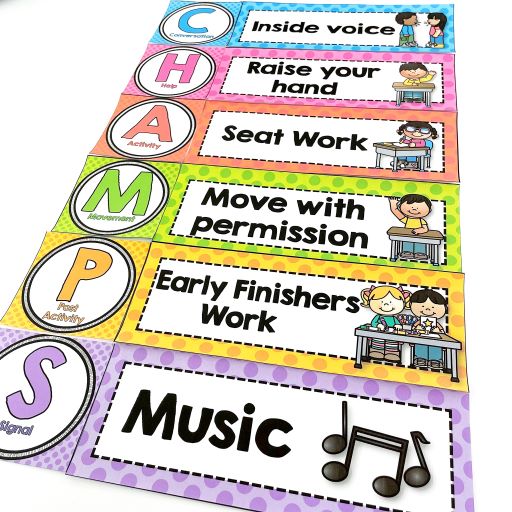Everyone has those students in their class that struggle to get their work done. This behavior can be seen in students who are struggling academically or high achievers. These attention issues range from slight to severe and can occur on a daily basis or show up sporadically.
As a teacher, it’s imperative to have a list of resources and tools at hand to use when a student is struggling with time management. No two students are the same, so you’ll probably have to adjust your methods with each passing year.
In this post, you’ll find a treasure trove of ideas and resources to help your students develop time management skills.
Prior to the Assignment
Step one in setting your students up for success is clearly communicating your expectations. Prior to releasing your students to work independently, consider how you communicate the following things:
- What materials does the student need to complete the assignment? Make sure students have everything right in front of them before they begin. This avoids wandering around the classroom. (Check out my Visual Direction Cards)
- How much time will they have to complete the assignment?
- What does success look like?
- Where will the assignment be turned in once it’s done?
- What activities are available after the work is finished?
I struggled with the last question for a long time until I came up with my early finisher task cards. Students need something they look forward to at the end of their assignments to help speed them along.
If you’d like to take a look at my early finisher cards and read the reviews from other teachers, just click on the link below. (I have them available for Pre-K, Kindergarten, 1st Grade, and 2nd Grade)
Early Finisher Task Cards

Another resource for sharing your expectations is visual cues in the CHAMPS Behavior Management System. If you’d like to learn more about this system, click on the link below:
CHAMPS Behavior Management System

Setting Up a Positive Environment
Personally, I can’t start working on a project until my house is relatively picked up. I love to listen to music, but there’s no way I can listen to it while I’m writing a blog post, I need silence. Everyone has their own idiosyncrasies (children and adults) in how they like to work.
Here are some things to think about as you design your classroom with time management in mind.
- Seating charts – for a student who is struggling with time management consider seating them next to a fast finisher or someone who’s slightly assertive and can keep them on track?
- Flexible seating – when students can choose where they work and the environment that works best for them it can be highly motivating.
- Working alone – would the student benefit from working in an individual space? This should never be done as a punishment or to cause embarrassment.
Here are some physical things students might need to stay on track. You can click on the link to see which ones I like.
- Timer – This can be set either by the teacher or students depending on the level of independence.
- Headphones – Depending on what you prefer, students can listen to some quiet music, or they can use the headphones to block out some of the classroom noise.
Communication with the Students
When you notice a time management issue, the best thing to do is pull the student aside and have a private conversation. You’d be amazed at how self-aware and self-reflective even kindergarten students can be! Here are some topics to discuss:
- What you’ve noticed – talk to them about when they get most distracted and ask if they know why it occurs.
- Tap into the feelings – get them to notice their feelings and triggers when their attention is waning.
- Plan together – talk about a solution together. Sometimes it can be as simple as a non-verbal cue to get them back on track. Other times, they might need an environment change or tools to assist them.
- Unfinished work – discuss what will happen with unfinished work and the consequences of not finishing. Never take away recess! These are the kids who need to get their energy out the most!
- Brain breaks – discuss what kind of brain breaks they can take. A sip of water, standing up and stretching, etc. Discuss how long these breaks should take as well. Sand timers can work really well for this! Below is a link for one-minute sand timers. That should be a good amount of time to take a break and refocus.
One-minute Sand Timers
Communication with Parents
Parents don’t always have to be involved in this process. If the problem is more severe, or the child is having time management issues both at home and school, it might be a good idea to partner with the parents. Here are some things to discuss during a conference:
- What you’ve noticed in class – make sure to find out what they notice at home as well.
- Communication with the student – discussions you’ve had with their child and what tactics you’ve used so far.
- The plan – what you intend to do going forward and how they can assist you both at school and at home.
- Consequences – will they have their incomplete work sent home? Make sure to notify the parents and set up expectations for when it needs to be returned.
- Follow-up – discuss how you will update the parents on their child’s progress and when the plan will be analyzed and modified.
Teacher To-Do’s
Here are some things you can do to minimize time management issues in your class:
- Schedule Review – Make it a part of every morning to review the daily schedule.
- Transition Warning – Give the students a warning when a transition is near. Keep it consistent at the one and five-minute mark for example.
- Schedule Consistency – As much as possible, keep the same schedule day-to-day and week-to-week.
- Check-ins – Decide when you are going to check in with the student and keep to that schedule. Maybe review the task individually before they start, or check in midway through the assignment.
- Praise, Praise, and more Praise – When they are on-task and following the plan be sure to give excessive praise to help them retrain their brain.
Whole-Class Instruction
We can all be better with our time management skills! When you notice one or more students are struggling with their time management you might want to start out with a whole group lesson. You can read the book – Don’t Dilly Dally Silly Sally and discuss ways they can stay focused.
After reading the book, have the whole class practice time management skills. All students could work on organizing their supplies ahead of time, choosing a smart seat, or moving quickly to the next assignment. Practice one strategy at a time, together.
Time management is part of our executive functioning skills and some people have an easier time with them than others. I know it can be frustrating when a student is continually off task, but it might not be a purposeful act of defiance. Students need to be explicitly taught time management skills, and the foundation that you give them when they are young can last a lifetime!






